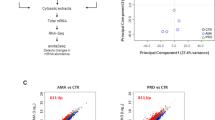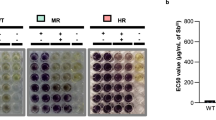Abstract
Leishmania is a group of parasitic protozoa that infect blood and tissue phagocytes including macrophages. We hypothesize that Leishmania is capable of establishing infection inside the macrophages because (a) they infect a subpopulation of macrophages; and (b) they “renovate” the macrophages before the establishment of infection. We found that only alternatively activated polarized M2 macrophages support Leishmania growth. Exposure of M2 macrophages to Leishmania promastigotes represses several selected RNA polymerase III (PolIII)-transcribed non-coding RNA (ncRNA) genes including those of 7SL RNA, vault RNA, and B2 RNA which have B-box element at their promoters. The B-box-binding transcription factor TFIIIC110 is down-regulated in Leishmania-exposed macrophages. Both the surface protease gp63 and the surface glycolipid LPG are required for the down-regulation of the ncRNAs in the M2 macrophages. We conclude that Leishmania surface gp63 collaborates with LPG to down-regulate TFIIIC110 in M2 macrophages to repress B-box containing ncRNA gene promoters.







Similar content being viewed by others
References
Bates PA (2006) Housekeeping by Leishmania. Trends Parasitol 22:447–448
Olivier M, Gregory DJ, Forget G (2005) Subversion mechanisms by which Leishmania parasites can escape the host immune response: a signaling point of view. Clin Microbiol Rev 18:293–305
Chang KP, Chaudhuri G, Fong D (1990) Molecular determinants of Leishmania virulence. Annu Rev Microbiol 44:499–529
Handman E, Bullen DV (2002) Interaction of Leishmania with the host macrophage. Trends Parasitol 18:332–334
Gregory DJ, Olivier M (2005) Subversion of host cell signaling by the protozoan parasite Leishmania. Parasitology 130:S27–S35
Denkers EY, Butcher BA (2005) Sabotage and exploitation in macrophages parasitized by intracellular protozoans. Trends Parasitol 21:35–41
Naderer T, Vince JE, McConville MJ (2004) Surface determinants of Leishmania parasites and their role in infectivity in the mammalian host. Curr Mol Med 4:649–665
Besteiro S, Williams RA, Morrison LS, Coombs GH, Mottram JC (2006) Endosome sorting and autophagy are essential for differentiation and virulence of Leishmania major. J Biol Chem 281:11384–11396
Nandan D, Reiner NE (2005) Leishmania donovani engages in regulatory interference by targeting macrophage protein tyrosine phosphatase SHP-1. Clin Immunol 114:266–277
Engwerda CR, Ato M, Kaye PM (2004) Macrophages, pathology and parasite persistence in experimental visceral leishmaniasis. Trends Parasitol 20:524–530
Matlashewski G (2001) Leishmania infection and virulence. Med Microbiol Immunol 190:37–42
Handman E (1999) Cell biology of Leishmania. Adv Parasitol 44:1–39
Alexander J, Satoskar AR, Russell DG (1999) Leishmania species: models of intracellular parasitism. J Cell Sci 112:2993–3002
Misra S, Tripathi MK, Chaudhuri G (2005) Down-regulation of 7SL RNA expression and impairment of vesicular protein transport pathways by Leishmania infection of macrophages. J Biol Chem 280:29364–29373
Egea PF, Stroud RM, Walter P (2005) Targeting proteins to membranes: structure of the signal recognition particle. Curr Opin Struct Biol 15:213–220
Gordon S (2003) Alternative activation of macrophages. Nat Rev Immunol 3:23–35
Mantovani A, Sica A, Locati M (2005) Macrophage polarization comes of age. Immunity 23:344–346
Tripathi MK, Misra S, Khedkar SV, Hamilton N, Irvin-Wilson C, Sharan C, Sealy L, Chaudhuri G (2005) Regulation of BRCA2 gene expression by the SLUG repressor protein in human breast cells. J Biol Chem 280:17163–17171
Martinez FO, Gordon S, Locati M, Mantovani A (2006) Transcriptional profiling of the human monocyte-to-macrophage differentiation and polarization: new molecules and patterns of gene expression. J Immunol 177:7303–7311
Misra S, Sharma S, Agarwal A, Khedkar SV, Tripathi MK, Mittal MK, Chaudhuri G (2010) Cell cycle-dependent regulation of the bi-directional overlapping promoter of human BRCA2/ZAR2 genes in breast cancer cells. Mol Cancer 9:50
Mittal MK, Myers JN, Bailey CK, Misra S, Chaudhuri G (2010) Mode of action of the retrogene product SNAI1P, a SNAIL homolog, in human breast cancer cells. Mol Biol Rep 37:1221–1227
Mittal MK, Myers JN, Misra S, Bailey CK, Chaudhuri G (2008) In vivo binding to and functional repression of the VDR gene promoter by SLUG in human breast cells. Biochem Biophys Res Commun 372:30–34
Chaudhuri G (1997) Scavenger receptor-mediated delivery of anti-miniexon antisense phosphorothioate oligonucleotide to Leishmania-infected macrophages: Selective and efficient elimination of the parasite. Biochem Pharmacol 53:385–391
Mishra M, Porter-Kelley J, Singh PK, Bennett JR, Chaudhuri G (2001) Enhanced activity of antisense phosphorothioate oligos against Leishmania amastigotes: augmented uptake of oligo, ribonuclease H activation and efficient target intervention under altered growth conditions. Biochem Pharmacol 62:569–580
Chaudhuri G, Chaudhuri M, Pan A, Chang KP (1989) Surface acid proteinase (gp63) of Leishmania mexicana. A metalloenzyme capable of protecting liposome-encapsulated proteins from phagolysosomal degradation by macrophages. J Biol Chem 264:7483–7489
Spath GF, Epstein L, Leader B, Singer SM, Avila HA, Turco SJ, Beverley SM (2003) Lipophosphoglycan is a virulence factor distinct from related glycoconjugates in the protozoan parasite Leishmania major. Proc Natl Acad Sci USA 97:9258–9263
Barron TL, Turco SJ (2006) Quantitation of Leishmania lipophosphoglycan repeat units by capillary electrophoresis. Biochim Biophys Acta 1760:710–714
Corradin S, Ransijn A, Corradin G, Bouvier J, Delgado MB, Fernandez-Carneado J, Mottram JC, Vergères G, Mauël J (2002) Novel peptide inhibitors of Leishmania gp63 based on the cleavage site of MARCKS (myristoylated alanine-rich C kinase substrate)-related protein. Biochem J 367:761–769
Anderson CF, Mendez S, Sacks DL (2005) Nonhealing infection despite Th1 polarization produced by a strain of Leishmania major in C57BL/6 mice. J Immunol 174:2934–2941
Müller K, Bischof S, Sommer F, Lohoff M, Solbach W, Laskay T (2003) Differential production of macrophage inflammatory protein 1gamma (MIP-1gamma), lymphotactin, and MIP-2 by CD4(+) Th subsets polarized in vitro and in vivo. Infect Immun 71:6178–6183
Gomes NA, Barreto-de-Souza V, DosReis GA (2000) Early in vitro priming of distinct T(h) cell subsets determines polarized growth of visceralizing Leishmania in macrophages. Int Immunol 12:1227–1233
Huang Y, Maraia RJ (2001) Comparison of the RNA polymerase III transcription machinery in Schizosaccharomyces pombe, Saccharomyces cerevisiae and human. Nucleic Acids Res 29:2675–2690
Geiduschek EP, Kassavetis GA (2001) The RNA polymerase III transcription apparatus. J Mol Biol 310:1–26
Schramm L, Hernandez N (2002) Recruitment of RNA polymerase III to its target promoters. Gen Dev 16:2593–2620
Englert M, Felis M, Junker V, Beier H (2004) Novel upstream and intragenic control elements for the RNA polymerase III-dependent transcription of human 7SL RNA genes. Biochimie 86:867–874
Cabart P, Lee J, Willis IM (2008) Facilitated recycling protects human RNA polymerase III from repression by Maf1 in vitro. J Biol Chem 283:36108–36117
Lee J, Moir RD, Willis IM (2009) Regulation of RNA polymerase III transcription involves SCH9-dependent and SCH9-independent branches of the target of rapamycin (TOR) pathway. J Biol Chem 284:12604–12608
Veras I, Rosen EM, Schramm L (2009) Inhibition of RNA polymerase III transcription by BRCA1. J Mol Biol 387:523–531
Felton-Edkins ZA, Kenneth NS, Brown TR, Daly NL, Gomez-Roman N, Grandori C, Eisenman RN, White RJ (2003) Direct regulation of RNA polymerase III transcription by RB, p53 and c-Myc. Cell Cycle 2:181–184
de Macedo CS, Shams-Eldin H, Smith TK, Schwarz RT, Azzouz N (2003) Inhibitors of glycosyl-phosphatidylinositol anchor biosynthesis. Biochimie 85:465–472
Thomas JR, Dwek RA, Rademacher TW (1990) Structure, biosynthesis, and function of glycosylphosphatidylinositols. Biochemistry 29:5413–5422
Macfarlane SR, Seatter MJ, Kanke T, Hunter GD, Plevin R (2001) Proteinase-activated receptors. Pharmacol Rev 53:245–282
Traynelis SF, Trejo J (2007) Protease-activated receptor signaling: new roles and regulatory mechanisms. Curr Opin Hematol 14:230–235
Talamás-Rohana P, Wright SD, Lennartz MR, Russell DG (1990) Lipophosphoglycan from Leishmania mexicana promastigotes binds to members of the CR3, p150, 95 and LFA-1 family of leukocyte integrins. J Immunol 144:4817–4824
Wilson ME, Hardin KK (1990) The major Leishmania donovani chagasi surface glycoprotein in tunicamycin-resistant promastigotes. J Immunol 144:4825–4834
Sturges MR, Peck LJ (1994) Calcium-dependent inactivation of RNA polymerase III transcription. J Biol Chem 269:5712–5719
Ponicsan SL, Kugel JF, Goodrich JA (2010) Genomic gems: SINE RNAs regulate mRNA production. Curr Opin Genet Dev 20:149–155
Mariner PD, Walters RD, Espinoza CA, Drullinger LF, Wagner SD, Kugel JF, Goodrich JA (2008) Human Alu RNA is a modular transacting repressor of mRNA transcription during heat shock. Mol Cell 29:499–509
Allen TA, Von Kaenel S, Goodrich JA, Kugel JF (2004) The SINE-encoded mouse B2 RNA represses mRNA transcription in response to heat shock. Nat Struct Mol Biol 11:816–821
Borchert GM, Lanier W, Davidson BL (2006) RNA polymerase III transcribes human microRNAs. Nat Struct Mol Biol 13:1097–1101
Acknowledgments
This project is supported in parts by NIAID grants 5R01AI042327, 1R21AI076757-01A1 and NIGMS grant #3 S06 GM008037-34-S2 to GC. Graduate student stipend is provided to ALF from the institutional training grants 2T32AI007281-21A1 and 5R25GM059994-10 from NIH.
Author information
Authors and Affiliations
Corresponding author
Electronic supplementary material
Below is the link to the electronic supplementary material.
Rights and permissions
About this article
Cite this article
Farrow, A.L., Rana, T., Mittal, M.K. et al. Leishmania-induced repression of selected non-coding RNA genes containing B-box element at their promoters in alternatively polarized M2 macrophages. Mol Cell Biochem 350, 47–57 (2011). https://doi.org/10.1007/s11010-010-0681-5
Received:
Accepted:
Published:
Issue Date:
DOI: https://doi.org/10.1007/s11010-010-0681-5




